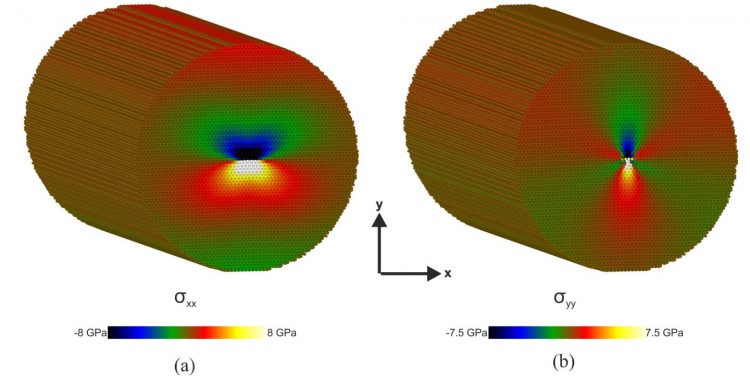The culprit of some GaN defects could be nitrogen

As silicon-based semiconductors reach performance limits, gallium nitride is becoming the next go-to material for several technologies. Holding GaN back, however, is its high numbers of defects. Better understanding how GaN defects form at the atomic level could improve the performance of the devices made using this material. Researchers have taken a significant step by examining and determining six core configurations of the GaN lattice. They present their findings in the Journal of Applied Physics. This image shoes the distribution of stresses per atom (a) and (b) of a-edge dislocations along the <1-100> direction in wurtzite GaN. Credit: Physics Department, Aristotle University of Thessaloniki
As silicon-based semiconductors reach their performance limits, gallium nitride (GaN) is becoming the next go-to material to advance light-emitting diode (LED) technologies, high-frequency transistors and photovoltaic devices. Holding GaN back, however, is its high numbers of defects.
This material degradation is due to dislocations — when atoms become displaced in the crystal lattice structure. When multiple dislocations simultaneously move from shear force, bonds along the lattice planes stretch and eventually break. As the atoms rearrange themselves to reform their bonds, some planes stay intact while others become permanently deformed, with only half planes in place. If the shear force is great enough, the dislocation will end up along the edge of the material.
Layering GaN on substrates of different materials makes the problem that much worse because the lattice structures typically don't align. This is why expanding our understanding of how GaN defects form at the atomic level could improve the performance of the devices made using this material.
A team of researchers has taken a significant step toward this goal by examining and determining six core configurations of the GaN lattice. They presented their findings in the Journal of Applied Physics, from AIP Publishing.
“The goal is to identify, process and characterize these dislocations to fully understand the impact of defects in GaN so we can find specific ways to optimize this material,” said Joseph Kioseoglou, a researcher at the Aristotle University of Thessaloniki and an author of the paper.
There are also problems that are intrinsic to the properties of GaN that result in unwanted effects like color shifts in the emission of GaN-based LEDs. According to Kioseoglou, this could potentially could be addressed by exploiting different growth orientations.
The researchers used computational analysis via molecular dynamics and density functional theory simulations to determine the structural and electronic properties of a-type basal edge dislocations along the <1-100> direction in GaN. Dislocations along this direction are common in semipolar growth orientations.
The study was based on three models with different core configurations. The first consisted of three nitrogen (N) atoms and one gallium (Ga) atom for the Ga polarity; the second had four N atoms and two Ga atoms; the third contained two N atoms and two Ga core-associated atoms. Molecular dynamic calculations were performed using approximately 15,000 atoms for each configuration.
The researchers found that the N polarity configurations exhibited significantly more states in the bandgap compared to the Ga polarity ones, with the N polar configurations presenting smaller bandgap values.
“There is a connection between the smaller bandgap values and the great number of states inside them,” said Kioseoglou. “These findings potentially demonstrate the role of nitrogen as a major contributor to dislocation-related effects in GaN-based devices.”
###
The article, “Structural and electronic properties of a-edge dislocations along <1-100> in GaN,” is authored by Stefanos Giaremis, Philomela Komninou, Imad Belabbas, Jun Chen and Joseph Kioseoglou. The article appeared in Journal of Applied Physics June 26, 2018, (DOI: 10.1063/1.5034198) and can be accessed at http://aip.
ABOUT THE JOURNAL
The Journal of Applied Physics is an influential international journal publishing significant new experimental and theoretical results of applied physics research. See http://jap.
Media Contact
More Information:
http://dx.doi.org/10.1063/1.5034198All latest news from the category: Physics and Astronomy
This area deals with the fundamental laws and building blocks of nature and how they interact, the properties and the behavior of matter, and research into space and time and their structures.
innovations-report provides in-depth reports and articles on subjects such as astrophysics, laser technologies, nuclear, quantum, particle and solid-state physics, nanotechnologies, planetary research and findings (Mars, Venus) and developments related to the Hubble Telescope.
Newest articles

NASA: Mystery of life’s handedness deepens
The mystery of why life uses molecules with specific orientations has deepened with a NASA-funded discovery that RNA — a key molecule thought to have potentially held the instructions for…

What are the effects of historic lithium mining on water quality?
Study reveals low levels of common contaminants but high levels of other elements in waters associated with an abandoned lithium mine. Lithium ore and mining waste from a historic lithium…

Quantum-inspired design boosts efficiency of heat-to-electricity conversion
Rice engineers take unconventional route to improving thermophotovoltaic systems. Researchers at Rice University have found a new way to improve a key element of thermophotovoltaic (TPV) systems, which convert heat…



